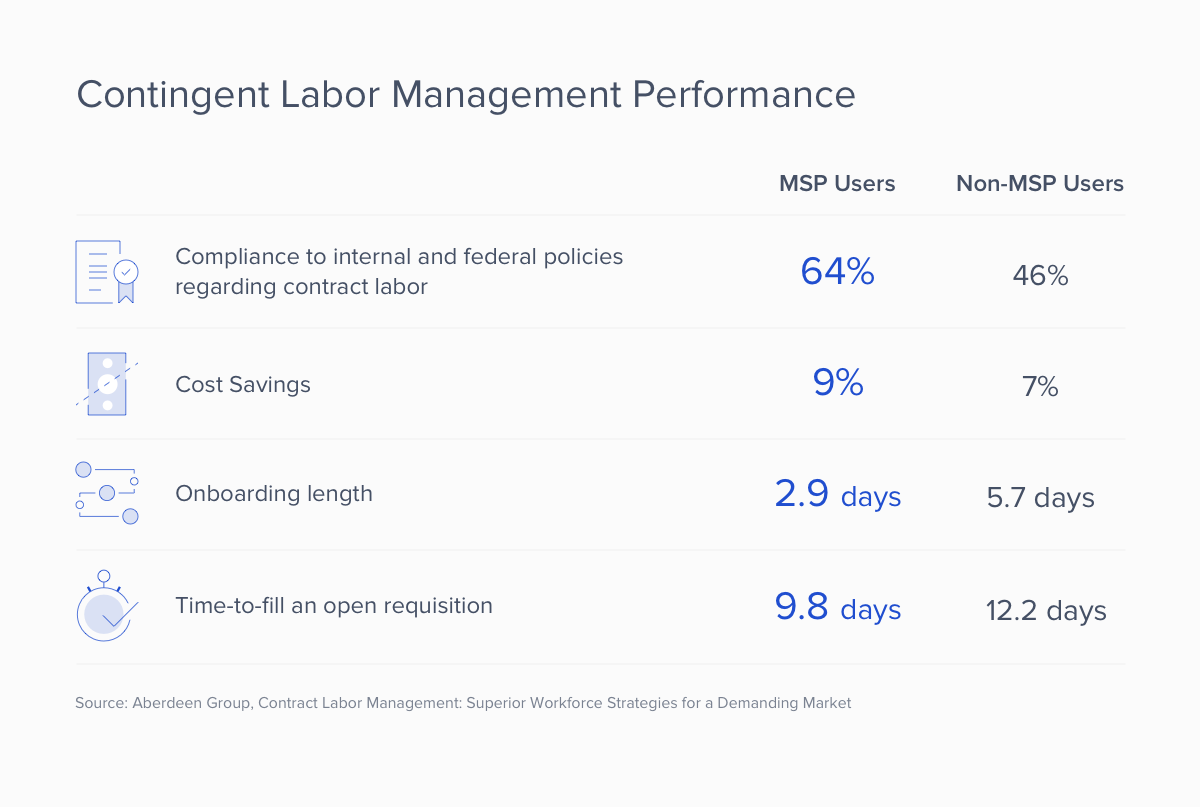Future of the MSP: Extinction or Evolution?
authors are vetted experts in their fields and write on topics in which they are extremely knowledgeable. All of our content is peer reviewed and validated by world-class professionals.

- MSP cost savings are lower today than 10 years ago.
- The ability of enterprise companies to fill positions quickly has increased substantially.
- MSPs that are not creating new value are in danger of obsolescence.
- Visit Staffing.com's homepage for more.
A managed service provider (MSP) is a company that serves as an intermediary between staffing companies and large enterprise clients. For years, this service was paramount in helping these organizations cut costs and improve efficiencies when securing a workforce. However, current trends leave many wondering if the MSP will continue to have a role in this equation, or if they will simply go extinct.
Staffing.com asked Chris Dwyer, vice president of research at Ardent Partners, just that. With 14 years as a supply management analyst with an active focus on the future of work, Dwyer feels strongly that the future of the MSP is bright -- for those that choose evolution over extinction.
The MSP of Yesteryear
Enterprise organizations who don’t wish to be involved in the intricate details of the contract labor process will often hire an MSP. In the past, doing so created a plethora of benefits to the organization by leveraging staffing knowledge and best practices.
According to ManpowerGroup, MSP benefits include:
- Cost savings
- Single point of contact for all contract labor activity
- Higher compliance rates
- Shorter onboarding times
- Shorter position vacancy rates
- Quality candidates

However, according to Dwyer, the MSP cost savings are lower today than in 2009, and an organization’s ability to fill positions quickly has increased substantially, leaving MSPs that have not evolved struggling to exist.
Challenges Facing Today’s MSP
Nearly all MSPs have the systems in place to address the traditional focus of contingent workforce programs: cost reduction and a simplified, standardized process. Few MSPs have evolved much beyond managing compliance issues and global expansion. This leaves many MSPs unable to meet the standards required by today’s organizations who are learning to cope with today’s trends.
Unless the MSP can evolve to meet the top needs of enterprise clients, they will become extinct. However, meeting these needs is not as easy as adding services. There are significant challenges that the MSP must overcome, including:
- Cost savings. According to Dwyer, in the past, the MSP found significant cost savings by working with preferred suppliers to get the best prices -- prices that an organization would be unable to get themselves. With the ability of organizations to utilize direct hiring sources, these cost savings are minimalized. For the MSP, this means they will need to start focusing on value rather than just savings. The MSP can create value by getting the best cost for the highest quality workforce in an efficient and low-risk way.
- New technology. Many MSPs have not invested in the technology that enterprise organizations require, including access to the human cloud. Not only will the MSP need to invest in technology, but they will have to become experts quickly in order to provide benefits to their clients. However, the MSP needs to remember that technology alone is not the complete solution for their evolution. They must consider business processes and customer service in conjunction with the new technology -- or the technology will be rendered ineffective.
- Dinosaur solution. One challenge often not considered when thinking of MSPs is the idea that the MSP is old school. “Younger executives who are used to today’s fast-paced technology and hell-bent on agility and innovation often reject solutions from the past,” says Dwyer. For the MSP to survive, they will have to show that they are not the MSP from yesteryear but are agile and innovative themselves.
- Individuality. Enterprise clients, like all consumers, want individualized services aimed at their specific wants and needs. Gone are the days of off-the-shelf solutions. MSP evolution will have to focus on understanding clients’ needs and creating customizable solutions.
Overcoming these challenges while focusing on their clients’ top priorities will be the keys for evolving MSPs.
5 Ways MSPs Can Remain Relevant
For MSPs that want to have a role in the future of work, the opportunity exists. Doing so will require that they update their services, adopt new technologies, and change their sourcing approach.
Here are five capabilities that new and improved MSPs will need in order to be relevant to today’s enterprise clients:
Multichannel strategy. Organizations have access to a wide array of options for talent sourcing and want their MSP to offer a variety of sourcing channels.
- Traditional staffing
- On-demand platforms
- Staff augmentation
- Statement of work
- Directly sourced
- Digital freelance networks
- Social media
- Employer review websites
Multichannel strategies offer the best talent for the position, regardless of the talent type.
In addition to sourcing through a variety of channels, the evolved MSP will leverage their knowledge of the industry to provide clients with an operational and effective multichannel strategy that they can’t effectively manage on their own.
Although some enterprise organizations may believe that they can manage an in-house multichannel strategy, Dwyer suggests that most do not understand how cost- and labor-intensive this can be. “It takes specialized employees who work solely within staffing to make a multichannel strategy effective,” he says. “You can’t just grab a few employees from different departments and expect internal workforce staffing to work.” Therefore, it will be inherent upon the MSP to show how their services are superior in cost, time, and quality.
- Consulting services. Dwyer suggests that adding consulting services to a multichannel strategy is the one-two punch that MSPs need. “Once they lead with sourcing strategies, they should follow up with subject matter experts to explain the best way to use these strategies,” he says. In the consulting role, the MSP helps create a contingent workforce approach, offer updated solutions based on new technologies and sourcing channels, and provide support to hiring managers. In essence, the MSP will become a partner rather than just a vendor.
- Adding predictive data analytics. By adding predictive data analytics, an MSP can improve the quality of an organization’s contingent labor force while saving them money on their labor costs. Predictive modeling can include such things as:
- Labor rates
- Talent performance
- Worker balance and performance
- Expanded services for workforce challenges. As MSPs evolve, they should consider offering services that help their clients achieve all their workforce objectives and goals. Services to consider include:
- Leadership development
- Analysis of the organization’s workforce investment
- Recommendation of new technologies
By taking a total management approach, the MSP can help clients save money, create unified contingent management processes, increase compliance, and enjoy the benefits of economies of scale.
- Expanded compliance and risk assessment. In many organizations, there is little strategic development when it comes to the contingent workforce. Without such a plan, an organization takes on many risks, such as:
- Breaking corporate policies
- Not using vetted talent sources
- Inconsistent contingent workforce policies
- Not following safety policies
- Inconsistent accounting practices
- Employee misclassification
- Contract errors
- Lack of indemnification
- OSHA incidents
By providing best practices for labor management, such as skills assessments, performance ratings, independent contractor risk assessments, and compliance reviews, the MSP can help protect their clients from costly issues.
The MSP has survived, even as other business services fail, due to their ability to evolve in ways that continue to meet client expectations. In today’s business climate, the MSP must strategically provide organizations with forward-looking workforce strategies that keep them nimble, agile, and innovative by being nimble, agile, and innovative themselves. Although many suggest that the digital economy and everything it brings with it will finally cause the MSP to become extinct, others, like Dwyer, believe that continued evolution will keep the MSP around for years to come.
